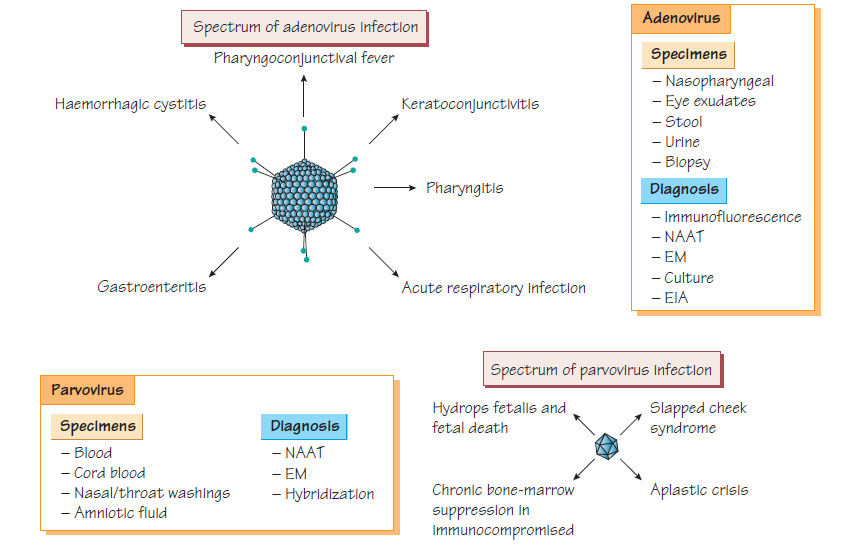DNA viruses: adenovirus, parvovirus and poxvirus
AdenovirusAdenoviruses are unenveloped, icosahedral, double-stranded DNA viruses that possess species-specific, group-specific and typespecific antigens. There are more than 50 serotypes of human adenoviruses, which are divided into six groups (A-F) on the basis of their genomic homology.
Epidemiology and Clinical features
- Transmitted by direct contact and faecal-oral route.
- Pharyngoconjunctival fever is caused by serotypes 3 and 7.
- Acute febrile pharyngitis is caused by serotypes 1-7.
- Serotypes 40 and 41 cause enteric infection.
- Serotypes 8, 19 and 37 cause conjunctivitis.
- Serotypes 4, 17 and 14 cause respiratory infection.
- Haemorrhagic cystitis is caused by serotypes 11 and 21.
- Immunocompromised patients may suffer severe pneumonia (serotypes 1-7), urethritis (serotype 37) and hepatitis in liver allografts.
- The clinical spectrum may vary depending on the site of infection.
Diagnosis
Diagnosis is usually made by nucleic acid amplification test (NAAT) but culture, serology and electron microscopy (EM) Diagnosis are available.
Prevention and control
Outbreaks must be managed according to infection control practices (both respiratory and contact). Outbreaks of ocular infection at swimming pools are prevented by adequate chlorination. Transmission between patients undergoing ophthalmic examination can be prevented by single-use equipment, adequate decontamination of equipment and appropriate hygiene by healthcare staff.
Parvoviruses are small, unenveloped, icosahedral, single-stranded DNA viruses with one serotype, B19, known to cause human disease and given the genus name Erythrovirus.
Epidemiology
Infection is found worldwide and throughout the year. Transmission is by the respiratory route. It may cause outbreaks of erythema infectiosum in schools. Seroprevalence increases with age with more than 60% of adults possessing antibody.
- Parvovirus B19 invades red blood cells through globoside P replicating in immature erythrocytes.
- It produces erythema infectiosum, a mild febrile disease that typically occurs in young children who may exhibit a 'slapped cheek' appearance.
- A symmetrical, small-joint arthritis may also develop, especially in adults.
- Red cell production is arrested by infection, which may cause severe anaemia in patients with a high red blood cell turnover (e.g. aplastic crises in patients with sickle cell disease).
- The risk of infection in pregnancy is low, but it may lead to hydrops fetalis and fetal death, although there is no evidence that parvovirus causes congenital abnormalities.
- Infection during the first 20 weeks of pregnancy results in 10% fetal loss.
Diagnosis
- Diagnosis is usually made clinically, but NAAT is the test of choice.
- Detection of IgM is also used.
- Blood, nasal or throat washings, cord blood and amniotic fluid can be examined by EM.
Prevention and control
No specific treatment or vaccine is available at present. Respiratory precautions should prevent transmission in the hospital environment.
These are small, enveloped, double-stranded DNA viruses with more than 100 types. Some are responsible for common warts and genital warts. Types 16 and 18 predominate in cervical neoplasia; they are transmitted by close contact, including by the sexual route. Diagnosis of a common wart is clinical; cervical neoplasm is diagnosed by cytology and NAAT. A vaccine against types 6, 11, 16 and 18 is now in use.
Poxvirus
Poxviruses are double-stranded DNA viruses with complex symmetry and a shape that resembles a ball of wool.
Smallpox
Once a major cause of death worldwide this has now been eradicated but there are concerns that smallpox may become a bioterrorism weapon, which have prompted some countries to produce stocks of vaccine.
Monkeypox
A zoonotic infection in rainforest areas of Central and West Africa that is similar to smallpox. The case fatality rate can reach 10% in Africa, but was much lower in the USA where there was an outbreak associated with infected prairie dogs. Diagnosis is by EM or NAAT.
A zoonotic, pustular dermatitis originating in sheep and goats that is characterized by a single vesicular lesion, which is typically found on the finger and resolves spontaneously after a few weeks. Diagnosis is usually clinical on the basis of appearance and a history of exposure.
Molluscum contagiosum
- A common condition, especially in children, with crops of small, regular, papular, 'pearl-like' skin lesions, usually occurring on the face, arms, buttocks and back.
- It may be transmitted sexually, by direct contact or on fomites.
- Steroid therapy and/or infection with HIV increase the extent of disease.
- The microscopic appearance is of epidermal hypertrophy that extends into the dermis, and cells with inclusion bodies that are seen in the prickle-cell layer.
- Diagnosis is usually clinical and can be confirmed by EM examination of lesion scrapings.
- The rash may last 1 year in immunocompetent individuals and may become a chronic problem for patients with HIV infection.
Traditional treatment - by prodding the lesions with a sharp implement - promotes healing.
Tanapox
Tanapox is a febrile illness usually associated with a single nodular skin lesion that may ulcerate and heal spontaneously. Infection is acquired in central and east Africa; the diagnosis is usually suggested by the travel history and can be confirmed by EM or NAAT.





